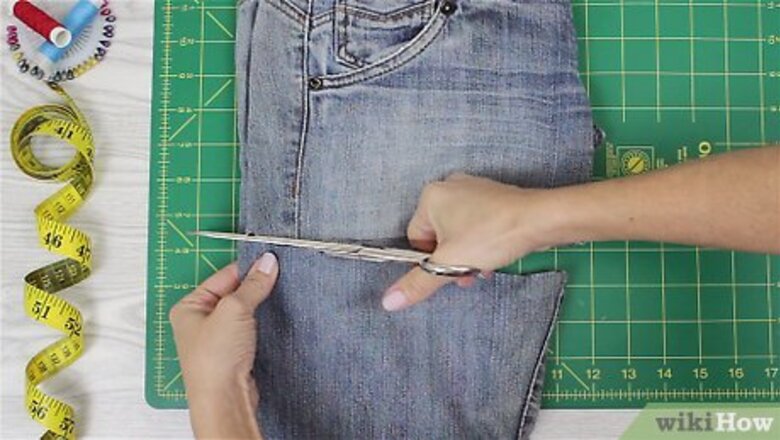
views
Making the Base
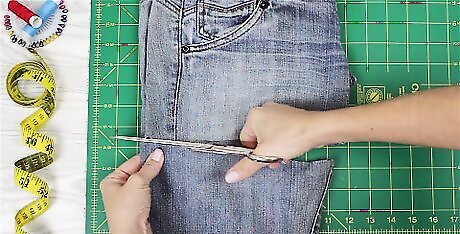
Cut the legs off of a pair of jeans. Start by cutting one of the legs off, just below the crotch. Fold the jeans in half, then use the cut leg as a guide for the second one. This will ensure that the bottom of the bag is even. Denim shorts, skirts, and capris will also work. If you are using a skirt, cut it ½ inch (1.27 centimeters) longer than you want the bag to be. You can use jeans that you already own, or buy a pair from a garage sale or second hand store.
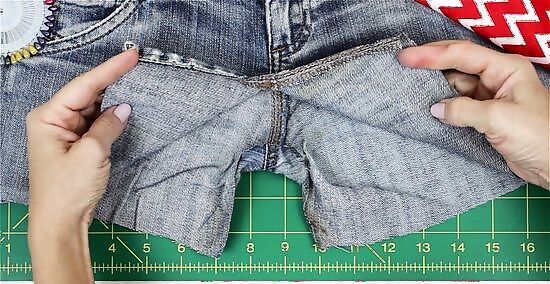
Cut open the crotch at the seam, then cut the seam off. Begin by cutting along the crotch seam so that the pants open up like a skirt. Next, cut the crotch seam off of the pants completely—this is the folded, top-stitched part. Doing this will even up the bottom of the pants and help reduce bulk.
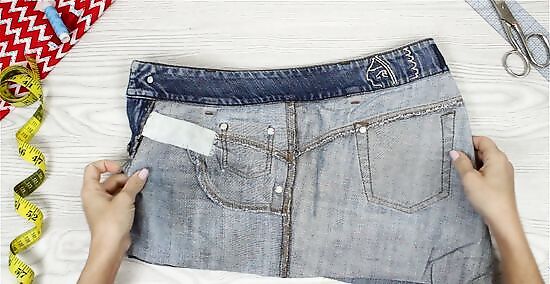
Turn the pants inside out and fold them in half the other way. You want the zipper to be on one side edge and the back seam on the other side edge. You will have a front pocket and a back pocket on both sides of the folded jeans. If you are using a denim skirt, simply turn it inside out.
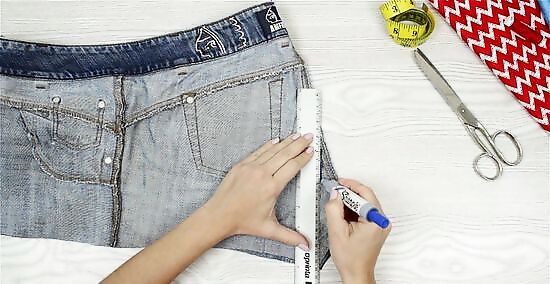
Sew down the new side edges so that they are straight. Sew straight down from the zipper to the bottom, cut edge of the pants. You will have a little triangle that used to be the crotch. Repeat this step for the back seam. Use a pen and ruler to draw guidelines if you have to. If you are using a denim skirt, skip this step.
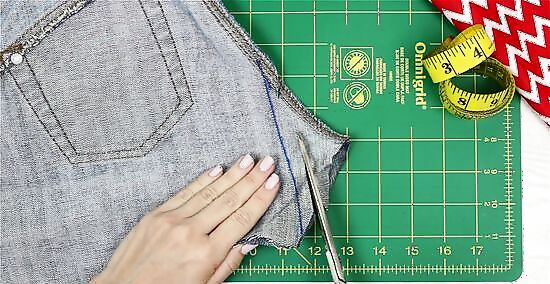
Cut off the triangle points. Your new side seams should now be straight. If you want to, you can press open the new side seams with an iron. If you are using a denim skirt, skip this step.
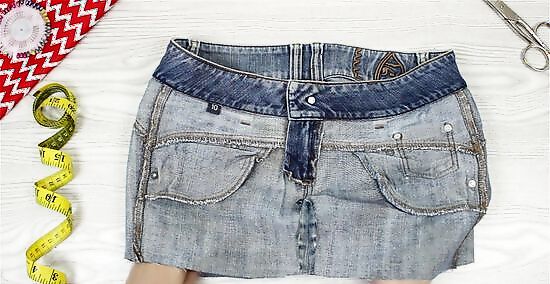
Fold the pants back the way they used to be. You should now have the zipper and front pockets on one side, and the back pockets on the other. The original size seams should be on the left and right edges. Make sure that all of the seams match up.
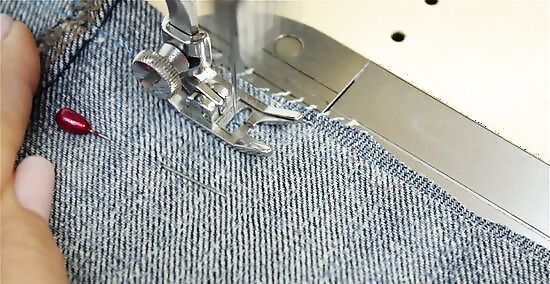
Sew across the bottom edge of the bag. Use a ½-inch (1.27-centimeter) seam allowance. Remember to backstitch at the start and end of your sewing and to go slowly over the seams. Trim off any overhanging fabric so that the bottom edge is even.
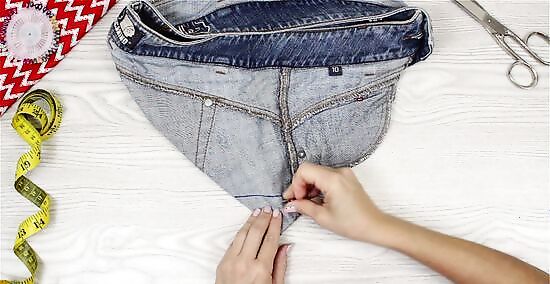
Sew across the bottom corners if you want a fancier bag. Flatten the base of the bag so that the bottom corners turn into flaps. Sew across each flap, about 2 inches (5.08 centimeters) away from each side edge. This will make the base of the bag wide enough so that it can stand up on its own when you set it down. If you want a simple bag, skip this step.
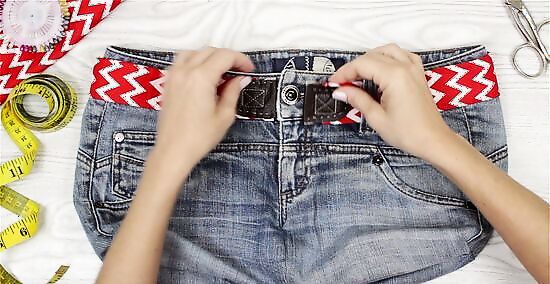
Consider adding some embellishments. You can skip this step if you want a simpler bag. If you want a fancier one, however, you should add the embellishments now before you add the straps and lining. Start by turning the bag right side out. Next, add some patches, embroidery, buttons, or studs—whatever you like! You can even stitch on some crocheted lace or a cut up doily onto the bag. Some items, such as studs, will need special tools.
Making the Handles
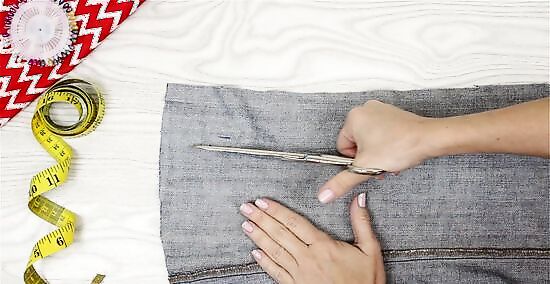
Cut a 2-inch (5.08-centimeter) wide strip from one of the pant legs you cut off. How long you make this strip depends on how long you want the strap to be. You can have one long shoulder strap. You can also cut it in half and make two shorter handles instead.
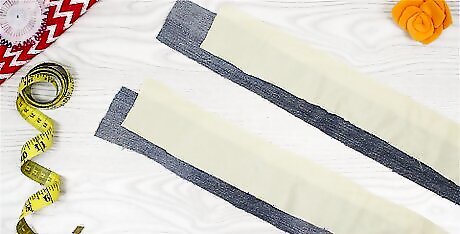
Cut a 2-inch wide strip out of cotton fabric for the lining. You can cut this from an old, button-up shirt, a pillowcase, or cotton fabric from the store. If you don't want a contrasting lining on your handle, cut another matching strip out of the other pant leg instead.
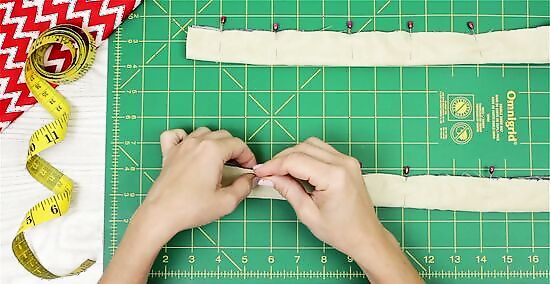
Pin the strips together. If you want clean, finished edges on your handles, pin the strips with the right sides facing in. If you want a rustic, raw edge on the handles, pin the strips together with the right sides facing out.
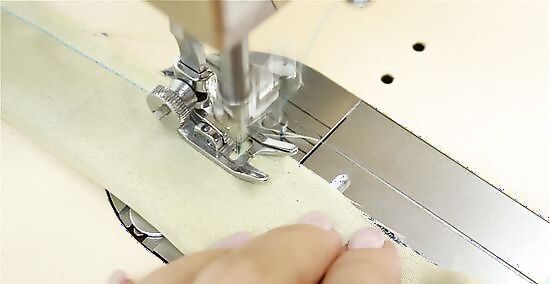
Sew the side edges of the strips together. Use a ¼ to ½-inch (0.64 to 1.27-centimeter) seam allowance. The smaller the seam allowance, the wider the strap will be. Do not sew across the two narrow edges.
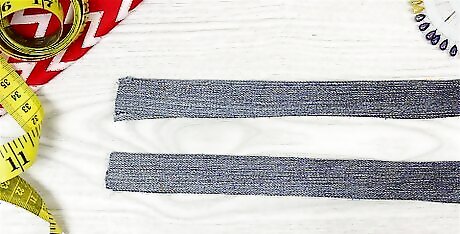
Turn the strips inside out, if needed. If you pin the strips with the right sides facing in, you will need to turn them inside out. This will hide the seams inside the strips and give you a clean, finished edge. If you pins the strips with the right sides facing out for a rustic finish, skip this step.
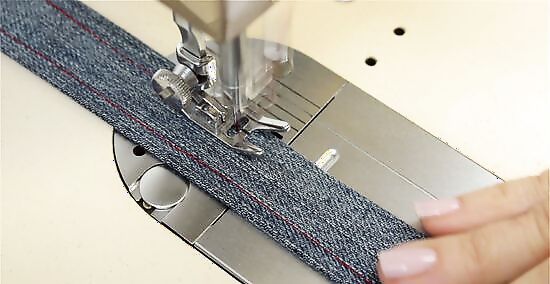
Top stitch the strips, if desired. If you turned the strips inside out, consider topstitching along the edges using a ⅛ to ¼-inch (0.32 to 0.64-centimeter) seam allowance. You can also sew straight down the handle for a nicer finish. This will work for both types of handles: finished or raw.
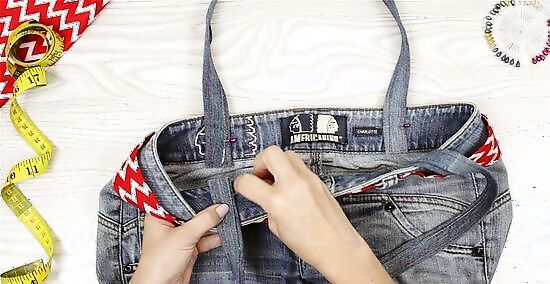
Pin the handle(s) to the inside of the bag. If you made one long shoulder strap, pin the narrow ends to the side seams on your bag. If you made two short handles, pin one handle to the front of the bag, and the other handle to the back. Keep the narrow ends a few inches apart. You can have the colored liner on the outside or the inside. The ends of the handles should be just below the waistband of the bag.
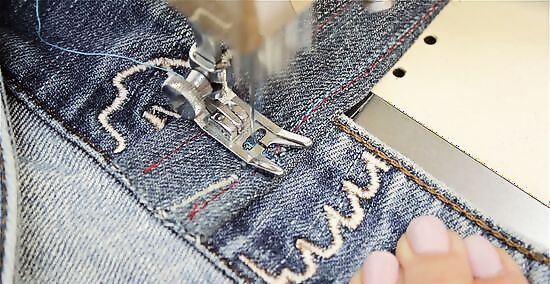
Sew the handles in place. Simply stitch back and forth across the bottom edge, using a ¼ to ½-inch (0.64 to 1.27-centimeter) seam allowance. If you want to, you can also sew across the top and sides of each handle, securing it further to the waistband of the bag. Remove the pins as you sew.
Making the Liner
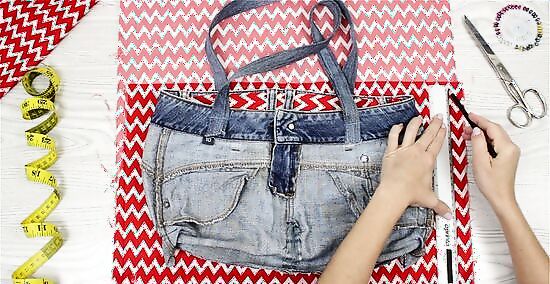
Trace the bag onto a button-up shirt for the lining. Add a ½-inch (1.27-centimeter) seam allowance to the bottom and side edges. Use a shirt with a bright, colorful pattern. You can also use cotton fabric instead, or even an old pillow case. Avoid tracing over any pockets, seams, or buttons.
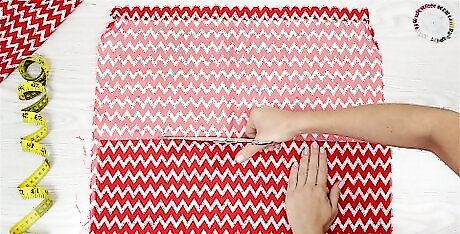
Cut the liner out. Try to cut through both layers of fabric at the same time. Remember to include the ½-inch seam allowances. If your shirt had a front pocket on it, consider cutting that out as well, as close to the seams as you can. You can add this pocket to the inside of your bag.
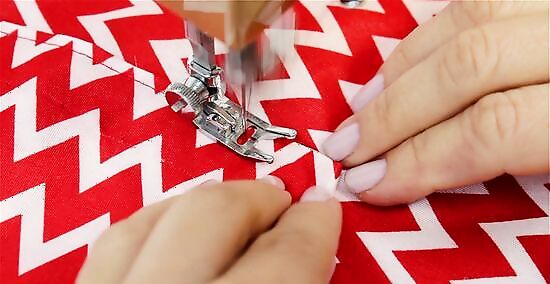
Sew a front pocket onto the lining, if desired. If you cut the front pocket off of your shirt, pin it to the right side of one of your lining pieces. Make sure that the bottom edge of the pocket is at least ½ inch (1.27-centimeters) away from the bottom edge of the lining. Topstitch the pocket down, following the original stitching as much as possible.
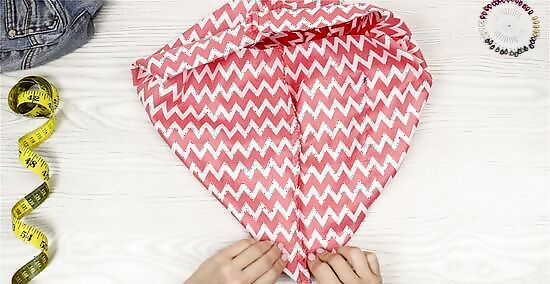
Pin and sew along the bottom and side edges of the liner. Pin the two pieces of fabric so that the wrong sides are facing out. Sew along the bottom and side edges using a ½-inch (1.27-centimeter) seam allowance. If you widened the bottom of your bag by sewing across the triangular flaps, you will need to do the same thing for the liner.
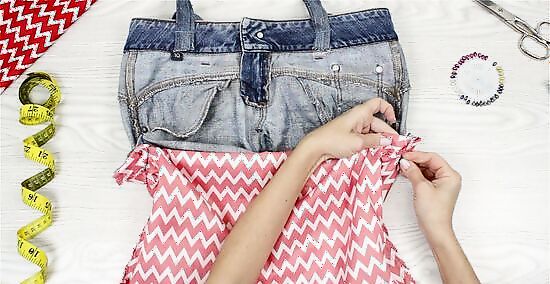
Sew the bottom flaps on the liner and bag together. Turn the bag and the liner inside out so that the wrong sides are facing out. Match up the bottom triangle flaps. Sew across them using the original stitching as a guide. This will help secure the lining to the back. If you made a simple bag without the widened bottom, skip this step.
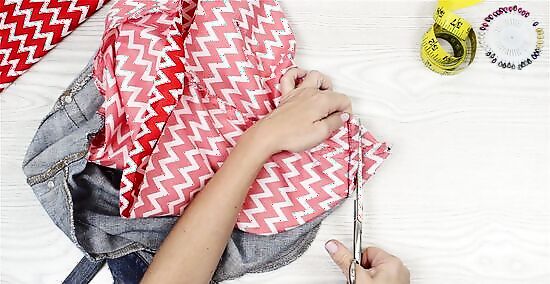
Trim the triangles flaps off, leaving a ¼-inch (0.64-centimeter) seam allowance. This will help reduce bulk. Serge the edges, or go over them with a zigzag stitch. If you made a simple bag, skip this step.
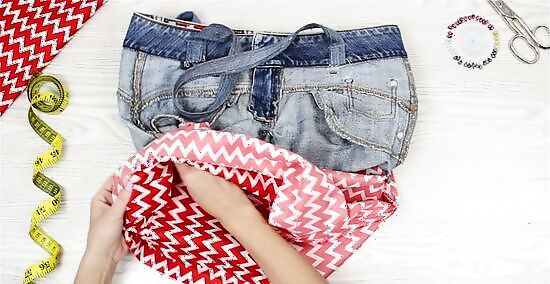
Fold the lining onto the bag. Tuck one hand into the bag. Use your other hand to roll the lining down onto the bag, like putting on a sock or a pair of pantyhose. When you are done, the lining should be right side out, with the bag tucked inside of it. If you made a simple bag, turn the lining right side out, then tuck the bag into the lining.
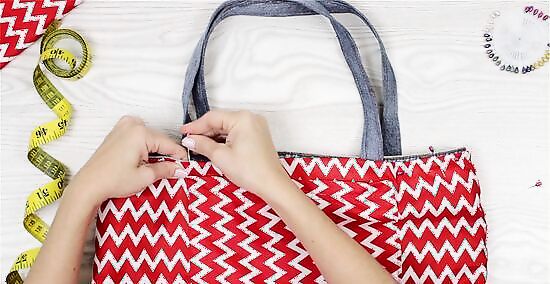
Fold the top edge of the lining down towards the waistband. Secure it with sewing pins as you go. For a crisper finish, press it flat with an iron. How far you fold the lining down is up to you. You can fold it past the waistband or halfway down the waistband. Make sure that you are folding towards the waistband so that the raw edge is tucked inside.
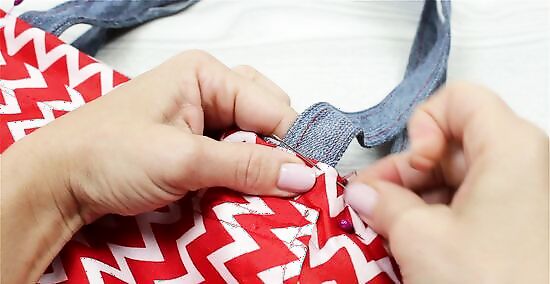
Sew across the top of the lining. You can do this on a sewing machine or by hand using a ladder stitch. If you are using a sewing machine, sew as close as you can to the top edge of the lining. If you are sewing by hand, make sure that you only sew through the inside layer of the waistband. Don't let the needle and thread come out the front. Machine sewing is only recommended if you folded the lining past the waistband, otherwise you will sew across the belt loops. If you are sewing on the machine, make sure that the bobbin color matches the jeans and the thread color matches the lining.
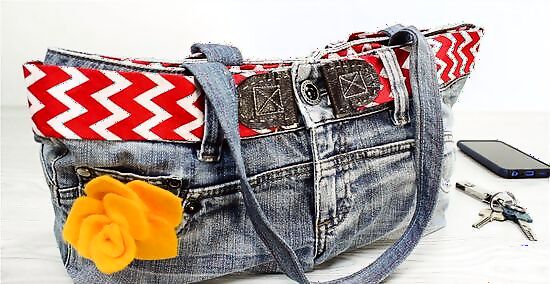
Turn the bag right side out. It is now ready to use! If you want to, you can embellish it with details to make it even more special. Here are some ideas to get you started: Weave a ribbon through the belt loops, then tie it into a bow over the front button. Weave a bandana or a leather belt through the belt loops for a rustic touch. Add a snap, button, or zipper closure to the bag. Decorate the bag further with fabric paint. Add some decorative pins or patches.














Comments
0 comment